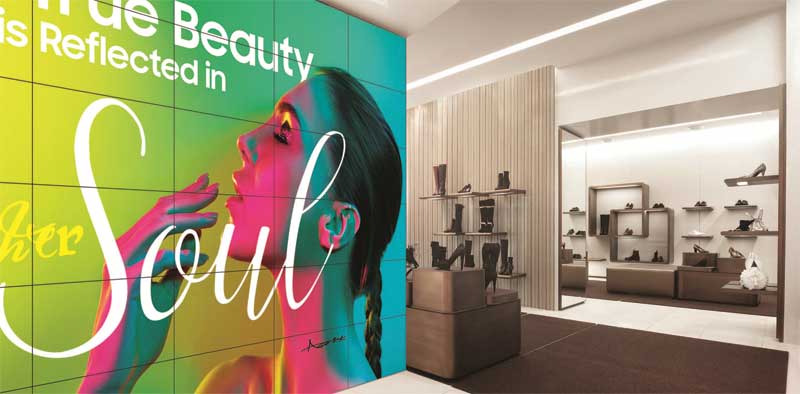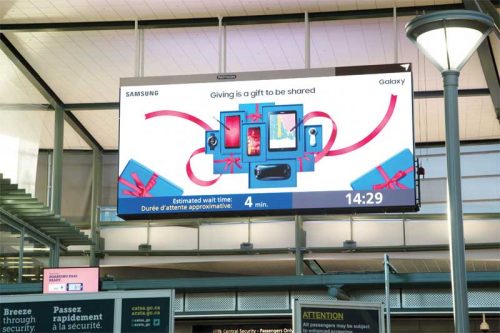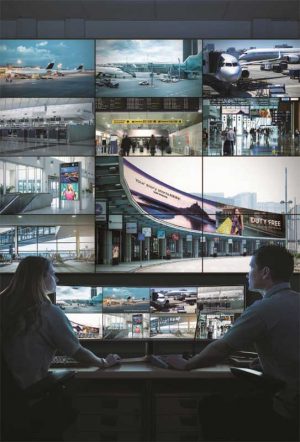Elevating any setting with video wall digital displays
by | 5 September 2019 2:31 pm
By Mary Peterson
 [1]
[1]In large retail environments, video walls are used as feature displays and as primary design features.
Visual displays and digital signage have come a long way and have experienced immense growth within the global video wall market in the last few years. That said, why is this trend starting to evolve so rapidly now? Many of the constraints businesses have experienced with video wall displays—like overcoming daylight glare and creating more customized shapes—are becoming issues of the past. Today, sign companies can offer their clients endless video wall capabilities thanks to the latest features of liquid crystal display (LCD) and light-emitting diode (LED) displays. These screens deliver a more immersive, realistic experience with added flexibility.
That said, video walls are not only successful because the technology fits. Getting the desired outcome of high-quality visuals through LCD and LED video walls requires strategic design, planning, and execution, which is illustrated through a number of instances discussed below. These examples explain how sign companies can use these different technologies to help businesses overcome challenges, as well as demonstrate the direction video walls are headed.
Two ways to build a video wall
The two most commonly used technologies for creating video walls are LCD and LED—two very different technologies that sometimes get confused.
The current generation of LCD video displays use LED lighting to illuminate a thin liquid crystal layer from behind or around the edges. The latest generation of indoor LED displays is also commonly referred to as ‘direct-view.’ This is due to the viewers’ ability to look directly at the tiny LEDs creating the visual. This differs from LCD, as these screens simply use LED technology as a hidden light source.
MicroLED technology, the latest innovation in LED displays, transfers micrometre-scale LEDs into modules. The result resembles wall tiles comprised of mass-transferred clusters of almost microscopic lights. Mounted together as a uniform canvas and plugged in, they create a visual experience similar to what one would get with premium quantum dot light-emitting diode (QLED) TVs.
LCD video walls
LCD video walls deliver high-definition visuals with some showcasing up to 4K ultra-high-definition (UHD) technology. One of the key features separating these displays from LED technology is the ability to have visuals look great from any distance or direction, including wide-viewing angles. Touch interactivity is another feature made possible, as it is easy to introduce by adding overlays or sensor frames around the perimeter of the display.
LCD video walls are often built by piecing individual displays together in a larger rectangle shape using a variety of clusters. In recent years, some new inventive shapes and clusters have adapted ideas such as herringbone patterns, or used unusual square LCDs to mix and match with more conventional rectangular displays.
What truly differentiate LCD from LED displays are the frames (bezels) around the edge, which hold the screens in place. Previously, LCD video walls had very noticeable gridlines because of thicker bezels, which resulted in interrupted visuals as they were disturbed by these large seams.
Today, with advances in display technology, the industry is seeing far thinner bezels. The effect is
the seams between the displays almost entirely disappear. LCD screens with ultra-narrow bezels typically carry a premium price. Costs decrease, however, as the bezels get thicker.
LED video walls
 [2]
[2]Video wall technology is heavily used at many airports, including Edmonton International Airport, where they feature everything from the estimated wait time at security to departure and arrival details.
Direct-view LEDs have been around for a while in the indoor market; however, recently, there has been noticeable growth as a result of the attention they are receiving for their use within a variety of industries.
This jump in interest is due to changes in ‘pixel pitch,’ which simply refers to the distance (in millimetres) between the LED light clusters in the digital display. The closer they are the better the resolution—especially when it is viewed up close.
Most commonly, LED display technology has been used on highway billboards, as stadium scoreboards,
or for running ads in high-traffic areas, such as Yonge-Dundas Square in downtown Toronto. These examples typically use lower resolution pixel pitches, generally 6 mm (0.2 in.) and higher, as the distance they are usually viewed from is quite far.
The new generation of fine pixel pitch indoor LEDs have gaps as fine as 1 mm (0.03 in.) or less. This means they can deliver 1080P HD viewing quality from just 3 m (10 ft) away, and stepping further back, most untrained eyes would struggle to even tell the difference between new generation LED displays and LCD screens.
One of the smallest pixel pitches available on the market features microLED technology, making it suitable for very small viewing distances, such as a conference room.
Case in point
The opportunities are endless, but the following is a quick look at some industries where sign companies have installed video wall technology.
Retail
The added full motion of digital signage with high-impact visuals reinforces the brand and sets the tone for a store. Video walls are used as feature displays in large retail environments, such as backdrops at checkout and customer service areas, but also as primary design features.
Financial institutions use LED walls in branches to create a stunning architectural feature which not only stops passersby in their tracks, but also provides a unique customer experience inside the branch.
Hospitality
As technology continues to shake up the hospitality industry, hotels are beginning to feature engaging video wall features in their lobbies and main entrances. These digital display solutions can enhance the design of any space, especially as hotels look to maintain their competitive edge and offer a unique and memorable experience for each guest.
A recent success story of how this display technology can be effectively implemented can be seen at Edmonton’s Fantasyland Hotel. Here, a large direct-view LED display was installed behind the reception desk to create a stunning visual impact for customers the moment they walk into the hotel. These high-quality displays are being used to relay a variety of messages (e.g. the latest updates on weather, local news, as well as promoting the hotel’s restaurants, spas, and local attractions), including useful traveller information to facilitate faster check-in.
Transportation
 [3]
[3]In some corporate office spaces, the sign industry is seeing a trend toward using video walls to enhance workplace culture and ambience.
Airports, train stations, and bus terminals are also adopting digital video wall technology to broaden the information that can be delivered to travellers. Airports in particular are starting to use wide strips of tiled displays to create changeable images at airline check-in counters and security screening areas. As pertinent travel information tends to change throughout the day, details displayed on a screen keep passengers as up-to-date as possible. This technology is already heavily used at many airports in Canada, including Toronto
Pearson International Airport and Edmonton International Airport, where they feature everything from the estimated wait time at security to departure and arrival details, as well as in-terminal restaurant and retail shop promotions and partner advertising.
Corporate spaces
In some corporate office spaces, the sign industry is seeing a trend toward using video walls to display public art to enhance workplace culture and ambience. In other cases, the bezel-less and fine pixel pitch advantages of a microLED video wall also makes it the ideal choice for installation in boardrooms or auditoriums.
Fit to purpose
 [4]
[4]A command and control room may use a high-resolution liquid crystal display (LCD) video wall to show the fine detail of images and charting.
With so many products to choose from, how can one ensure he/she is selecting the best technology that suits their company’s needs? The following are some aspects a sign company can discuss with their client to help him/her evaluate the different technologies.
- Shape: There can be limitations when it comes to setting up LCD displays, usually resulting in more rectangular shaped video walls. Because LED modules piece together like tiles, a more custom-shaped display is achievable. This makes LED displays more suitable to fit into spaces with odd and varied dimensions, including the ability to wrap various configurations.
- Lighting: In an area where there are more ambient lighting conditions, LCD displays do not have sufficient light power to make visuals cut through glare. However, some manufacturers offer premium, daylight-readable displays, which work well even
in direct sunlight. With LED screens, designed-in brightness wins those battles against direct sunlight. By sharing this knowledge with clients, sign companies can make sure their customers know about the available offerings. - Distance: When searching for the best display, distance of viewers from the visual needs to be determined. Close proximity best suits LCD because visuals will look vivid and sharp even up close. However, if viewers will be at a distance of 3 m (10 ft) or more, a relatively low-cost 1.5-mm (0.06-in.) pixel-pitch LED video wall will deliver big, rich, and seam-free visuals.
- Content: Before one can decide on the best technology to implement, businesses are in the best position to determine
what type of information they will be communicating on-screen. For example, a command and control room may use a high-resolution LCD video wall to show the fine detail of images and charting. On the other hand, a lobby of an office may require a large LED display to create a visual experience for visitors. - Physical constraints: If space is a concern, a sign company has the option of mounting systems that pull out to allow rear servicing, or LED displays that offer thin side profiles, which can be installed and serviced from the front.
From ideation to execution
 [5]
[5]Before one can decide on the best technology to implement, it must be determined what will be communicated on-screen.
A large video wall may simply appear as a giant television, but it can be so much more—especially considering all that happens from ideation through to execution. At any stage, it is easy to get things wrong. That said, the best advice for sign companies is to work with a display manufacturer/partner to work out the objectives, strategy, capital, and operating budgets.
Businesses must fully understand what will be communicated or displayed on the digital signage before making technological decisions as the design and scale of content has a direct influence on these choices. If a video wall project goes awry, the client is left with one very big monitor taking up space. However, when everything goes as planned, the client has a compelling digital canvas that powerfully drives and delivers on their objectives.
A seasoned enterprise business leader and expert in sales channel marketing, Mary Peterson is vice-president, IT and enterprise solutions for Samsung Canada where she shapes the strategic vision for the company’s IT B2B division in Canada. Throughout her more than 30-year career in the technology industry, she has created successful business divisions within the Canadian operations of some of the world’s most respected technology companies.
- [Image]: https://www.signmedia.ca/wp-content/uploads/2019/09/video-wall-retail.jpg
- [Image]: https://www.signmedia.ca/wp-content/uploads/2019/09/Edmonton-Airport.jpg
- [Image]: https://www.signmedia.ca/wp-content/uploads/2019/09/Video-Wall.jpg
- [Image]: https://www.signmedia.ca/wp-content/uploads/2019/09/video-wall-control-room.jpg
- [Image]: https://www.signmedia.ca/wp-content/uploads/2019/09/video-wall-museum.jpg
Source URL: https://www.signmedia.ca/elevating-any-setting-with-video-wall-digital-displays/